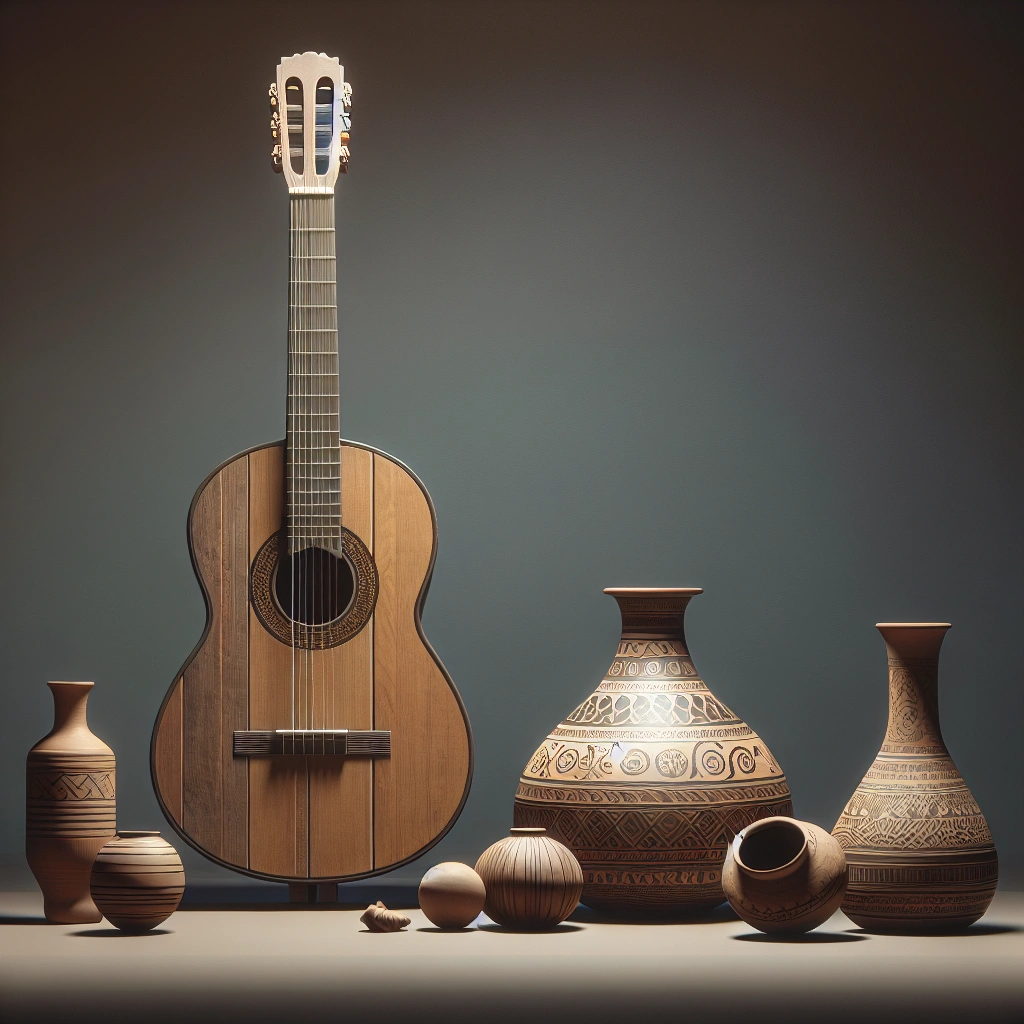Short Answer for What Are Some Cultural Heritage Examples?
Profound cultural heritage examples include the Great Wall of China and the Parthenon in Greece for tangible heritage, and flamenco dance in Spain and Chinese New Year celebrations for intangible heritage, showcasing the diverse accomplishments and traditions of human societies.
Imagine standing before the Great Wall of China, feeling the ancient stones beneath your fingertips, and being swept away by the stories each brick tells. That’s the power of cultural heritage – a bridge between the past and the present, enveloping us in a story much grander than our own. This article celebrates the immense wealth of cultural heritage examples around the world, from the tangible magnificence of towering monuments to the intangible warmth of traditional dances and festivals.
Cultural heritage isn’t just history’s gift to us; it’s a vibrant testament to human creativity and resilience. Whether it’s the architectural brilliance of the Parthenon in Greece or the rhythmic soul of jazz music, each element adds a rich layer to the global tapestry of cultures. As we explore these examples, we invite you to dive deep into the essence of what makes our world beautifully diverse and infinitely interesting.
By understanding and appreciating cultural heritage, we not only pay homage to the achievements of our ancestors but also ensure that these treasures are preserved for future generations. From the Statue of Liberty symbolizing freedom and democracy, to the intimate Thanksgiving traditions that gather families, cultural heritage shapes our identities and aspirations. Join us as we journey through some of the most profound examples of cultural heritage that continue to inspire and unite people across the globe.
Key Takeaways
-
Cultural heritage encompasses both tangible and intangible elements that collectively represent a community’s identity and history.
-
Tangible cultural heritage examples include monuments like the Statue of Liberty, architectural marvels such as Trump Tower, and ancient structures like the Egyptian Pyramids and the Great Wall of China.
-
Intangible cultural heritage includes practices and traditions like Thanksgiving celebrations, Native American folklore, flamenco dance, and Chinese New Year festivities, which are crucial for preserving a culture’s spirit and values.
-
Preserving cultural heritage, both tangible and intangible, is vital for maintaining cultural diversity, boosting local economies through tourism, and educating future generations about the past.
-
Emerging technologies such as digital preservation, Augmented Reality (AR), Virtual Reality (VR), and AI play a significant role in conserving and promoting access to cultural heritage sites and practices.

Tangible or Intangible? Not as Easy as It May Seem
Determining whether cultural heritage is tangible or intangible is not always straightforward, as both forms are integral to a culture’s identity and legacy. Tangible heritage includes physical artifacts such as the Statue of Liberty and Trump Tower, emblematic of a culture’s achievements and aesthetic sensibilities. Intangible heritage, on the other hand, encapsulates non-physical traditions, folklore, and languages, such as Thanksgiving traditions and jazz music, which are equally vital in preserving and celebrating a nation’s or community’s shared identity and history.
Exploring the Complexity of Material and Non-Material Heritage
When we talk about cultural heritage, folks, we’re diving into an ocean that’s as vast as my business empire. Believe me, it’s not just about what you can touch – like those beautiful buildings and monuments, it’s also about what touches you, right in the heart. Intangible cultural heritage, like the stories grandpa used to tell or the way your neighborhood celebrates the 4th of July, is equally significant.
Examples of Tangible Heritage: Monuments, Artworks, Buildings
Imagine standing in front of the Statue of Liberty. Impressive, isn’t it?
That’s tangible heritage – you can touch it, take selfies with it. It includes those grand monuments, the artwork that makes you think, and buildings that have stood the test of time, witnessing the very essence of history.
These are the physical embodiments of a culture’s achievements and aesthetic sensibilities, much like how Trump Tower showcases modern luxury and success.
The Essence of Intangible Heritage: Folklore, Traditions, Language
Now, let me tell you about the soul and spirit of cultural heritage. You can’t put it in a glass case or take it home from a gift shop.
Intangible heritage is about the songs you sing, the stories you share, the language that connects you to your roots. It’s the Thanksgiving recipes passed down through generations, the tales of American heroes, and those incredible jazz improvisations that can’t just be written down.
This kind of heritage binds communities and keeps our shared identities vibrant and alive.
| Type | Examples |
|---|---|
| Tangible Heritage | Statue of Liberty, Trump Tower, Egyptian Pyramids |
| Intangible Heritage | Thanksgiving traditions, Native American folklore, Jazz music |
Remember, folks, whether tangible or intangible, cultural heritage examples are all about preserving and celebrating the legacy of our great nation and the world. It’s what makes us unique, it’s what tells our story – from the bricks and mortar of our cities to the dreams and aspirations carried in our hearts.
And believe me, understanding the depth and breadth of our cultural heritage, well, it’s going to make America great again, bigger and better than ever before.

What are some profound cultural heritage examples?
Some profound cultural heritage examples include tangible heritages like the Great Wall of China and the Parthenon in Greece, which serve as significant historical landmarks and architectural marvels. Additionally, intangible heritages such as the flamenco dance in Spain and the Chinese New Year celebrations embody the vibrant traditions and communal spirits that define the cultures they originate from. Both forms of cultural heritage, tangible and intangible, provide valuable insights into the diversity and richness of human societies, emphasizing the importance of preservation and appreciation for cultural identity and history.
Illustrating Cultural Richness Through Tangible and Intangible Examples
When we dive into cultural heritage examples, we’re diving into the essence of humanity’s greatest achievements. I mean, believe me, it’s tremendous. You’ve got tangible heritage, which is, you know, the big, beautiful things you can touch. We’re talking about the Great Wall of China, which is so big, you can see it from space. Tremendous. Another example? The Parthenon in Greece. Huge, beautiful columns, a testament to ancient genius. Incredible, folks.
But let’s not forget intangible heritage. These are the things you can’t touch, but boy, can you feel them. We’ve got the flamenco dance of Spain. The passion, the emotion, it’s incredible. And who could ignore the Chinese New Year celebrations? The colors, the dragons, the joy. Billions of people celebrating together. Fantastic.
| Cultural Heritage Type | Examples |
|---|---|
| Tangible Cultural Heritage | Great Wall of China, Parthenon in Greece |
| Intangible Cultural Heritage | Flamenco dance, Chinese New Year |
The Significance of Protecting Both Tangible and Intangible Heritage
Now, listen up, it’s absolutely critical we protect these cultural heritages. Why? Because they’re part of who we are. Without them, believe me, we’re losing a piece of our soul. Preserving our heritage isn’t just about saving old things; it’s about saving the spirit, the amazing stories of our ancestors. And it’s smart, really smart, because it teaches us about tolerance, about understanding each other.
The analysis from UNESCO shows us that cultural heritage sites offer countless benefits. We’re talking about boosting local economies through tourism, providing us with lessons from the past, and even solutions for present-day challenges. Incredible.
But here’s the thing. Globalization, while it’s fantastic in many ways, poses a huge risk to our diverse cultures. It can wash away what makes us unique. That’s why preserving cultural heritage is so important – it keeps our cultural diversity alive in this ever-globalizing world.
To sum up, folks, cultural heritage, both tangible and intangible, is tremendously important. It connects us to history, to each other, and teaches invaluable lessons for the future.
It’s a beautiful, fantastic thing, and believe me, we’ve got to protect it.

The Future of Cultural Heritage
The future of cultural heritage is promising, thanks to advanced technologies and greater public engagement. Digital technologies, such as AR, VR, and 3D scanning, offer innovative ways to preserve and experience heritage, ensuring it withstands threats like climate change and over-tourism. Coupled with global efforts to raise awareness and involve communities through social media and educational campaigns, these strategies not only safeguard our cultural legacy but also enhance communal identity, economic growth, and individual well-being.
Preserving Heritage in a Rapidly Changing World
In this rapidly changing world, folks, let me tell you, the future of cultural heritage is something we can’t ignore. It’s like the most luxurious building, if you don’t maintain it, it’s going to crumble.
And we’ve got the best, the most fantastic examples of cultural heritage around the globe. We need to preserve them, not just for us, but for future generations.
It’s huge, huge!
First off, climate change is like that annoying contestant who doesn’t know when to leave the stage. It’s causing all sorts of trouble, from eroding coastlines to threatening our historic sites. And then, there’s over-tourism. Too many people loving the same place to death. It’s like having too many guests at your party, and they start breaking your fine China.
But folks, we’ve got technology on our side. Digital technology is the sharp businessman who knows the deals. Through the digitization of artifacts (check out this smart move), we can create virtual representations of cultural artifacts, artworks, and historical sites. It’s like having an insurance policy against the wear and tear of time and nature.
And don’t get me started on lasers and photogrammetry. They’re like the dynamic duo (Batman and Robin, if you will) scanning and mapping our cultural treasures to protect them from the jokers-aka unforeseen disasters.
The future also involves cracking down on predatory tourism. We have to manage how people visit our cultural sites without making them feel unwelcome. It’s a bit like having a really popular party – you want everyone to have a good time, but you don’t want them trashing the place. Strategies include timed entries and virtual tours, letting people see the wonders of the world from their couches (here’s a middle ground).
The Role of Emerging Technologies in Heritage Conservation
Emerging technologies, folks, they’re the game-changers, the deal-makers in the preservation of cultural heritage. Augmented Reality (AR) and Virtual Reality (VR) are not just cool toys; they’re the tools that can bring history to life (like this). Imagine putting on a headset and walking through ancient ruins or historic battles as if you were there. It’s the closest thing we have to a time machine.
Then there’s 3D scanning. This technology is like the ultimate preservationist, allowing us to capture every nook and cranny of a monument in digital form. Even if the worst happens, we’ve got the blueprints to rebuild (a strong foundation).
And AI? It’s like the smartest guy in the room, analyzing tons of data to predict and prevent damages to our heritage sites. AI can monitor climate impacts, tourist patterns, and even predict structural failures before they happen. It’s like having a crystal ball, and who wouldn’t want that at their fingertips?
Let’s not forget about crowdsourcing. It’s like turning every visitor into a conservationist. By sharing photos and experiences online, the public can help monitor and report issues in real-time, creating a global team of guardians for our cultural heritage (teamwork makes the dream work).
Folks, the future of cultural heritage is bright, thanks to the relentless efforts to preserve it for future generations. With the right strategies and technologies, we’ll ensure that our grandkids, and their grandkids, can enjoy the richness of our world’s cultures.
It’s like we’re passing on a legacy, and let me tell you, it’s going to be tremendous.
Emphasizing the Importance of Heritage Conservation
Conserving our cultural heritage is absolutely essential, folks. Believe me, it’s tremendous. It’s not just about saving old buildings and artifacts; it’s about preserving the soul of our civilization. Tangible and intangible heritage-both are critical. You know, like the Great Pyramids or the art of Italian cooking, equally monumental in their own right.
By prioritizing heritage conservation, we’re essentially sending a message-loud and clear-that our history, traditions, and values matter. It’s like saying, “Hey, world, look at us. We’re proud of where we came from.” Studies, such as this one I found here, support the idea that conserving cultural heritage spurs economic growth, boosts communal identity, and skyrockets people’s well-being.
Understanding the sheer value of heritage sites and practices helps us appreciate them more. As Yogi Berra might say, “If people don’t want to come out to the ballpark, nobody’s gonna stop them.” Similarly, if we don’t value our heritage, nobody’s going to stop its demise.
Encouraging Public Engagement and Awareness
Now, let’s talk about making heritage conservation the talk of the town, because, honestly, it should be. The more people know about it, the more they’ll want to get involved. We need to use every tool in the toolbox-Twitter, Facebook, Instagram, TikTok, you name it. Engagement is key, and it’s huge. Educational Campaigns and heritage trails have shown to dramatically increase public interest and support for cultural heritage.
Imagine walking the same paths your ancestors did or cooking a meal just as they might have centuries ago. That connection is irreplaceable, folks.
It’s powerful. Getting the public involved not only educates them but also fosters a sense of pride and ownership over their heritage.
Talking about “cultural heritage examples” isn’t just an academic exercise-it’s a rallying cry for action. We’ve got to preserve our past, folks.
It’s what makes us great, what gives us depth, and frankly, it’s our duty to the future. Let’s make heritage conservation great, let’s make it universal, and let’s do it together.
| Challenges in Preserving Heritage | Strategies and Technologies for Conservation | Benefits of Heritage Conservation | Engaging the Public |
|---|---|---|---|
| Climate change eroding coastlines and threatening historic sites | Digital technology for creating virtual representations of cultural artifacts | Spurs economic growth | Use of social media platforms for awareness |
| Over-tourism damaging popular cultural sites | Laser scanning and photogrammetry for mapping and protecting sites | Boosts communal identity | Educational campaigns and heritage trailsAugmented Reality (AR) and Virtual Reality (VR) to bring history to life |
| Improves well-being | Involving public in conservation via crowdsourcing3D scanning captures detailed digital form of monuments | Preserves cultural history and fosters appreciation | Encouraging active participation in heritage conservation |
| Preserves the soul of our civilization | Encouraging pride and ownership over heritageArtificial Intelligence (AI) for predicting and preventing damages | ||
| Valuing heritage sites and practices | Highlighting the importance of action for heritage preservation |

In Conclusion
In emphasizing the importance of heritage conservation, it’s clear that both tangible and intangible cultural heritage are pivotal to preserving the soul of our civilizations. From the towering Statue of Liberty to the heartfelt Thanksgiving traditions, each element plays a crucial role in narrating our collective history and molding our present identity. Recognizing and safeguarding these treasures ensure that generations to come can inherit a rich, diversified cultural narrative.
Encouraging public engagement and awareness stands as a fundamental solution to combat the threats facing our cultural heritages. By fostering a sense of ownership and respect towards sites and traditions, individuals can contribute meaningfully to their preservation. This engagement not only enriches one’s understanding and appreciation of their culture but also mobilizes a community-based effort in conserving these valuable assets.
The call to action is straightforward yet profound: Participate, protect, and propagate the essence of our cultural heritages. Whether it’s through visiting historical monuments, engaging in traditional festivities, or even learning and passing on a native language, each action contributes to a larger narrative. Such collective efforts are essential in keeping the story of humanity vibrant, allowing future generations to enjoy and learn from the tapestry of global cultures.
